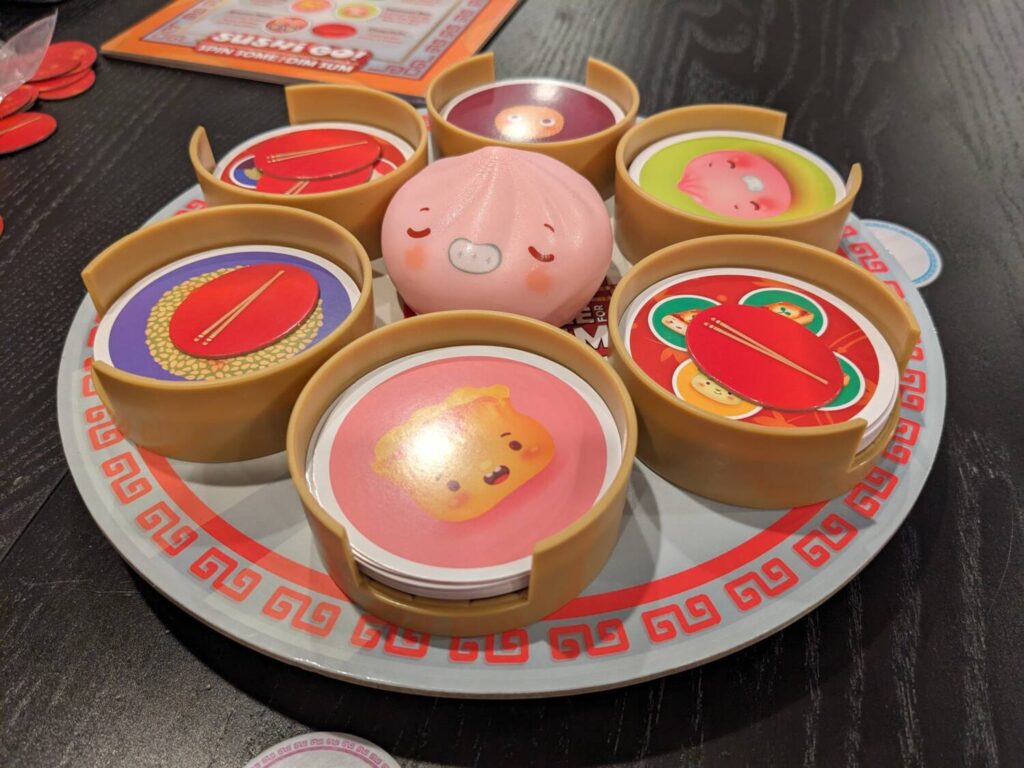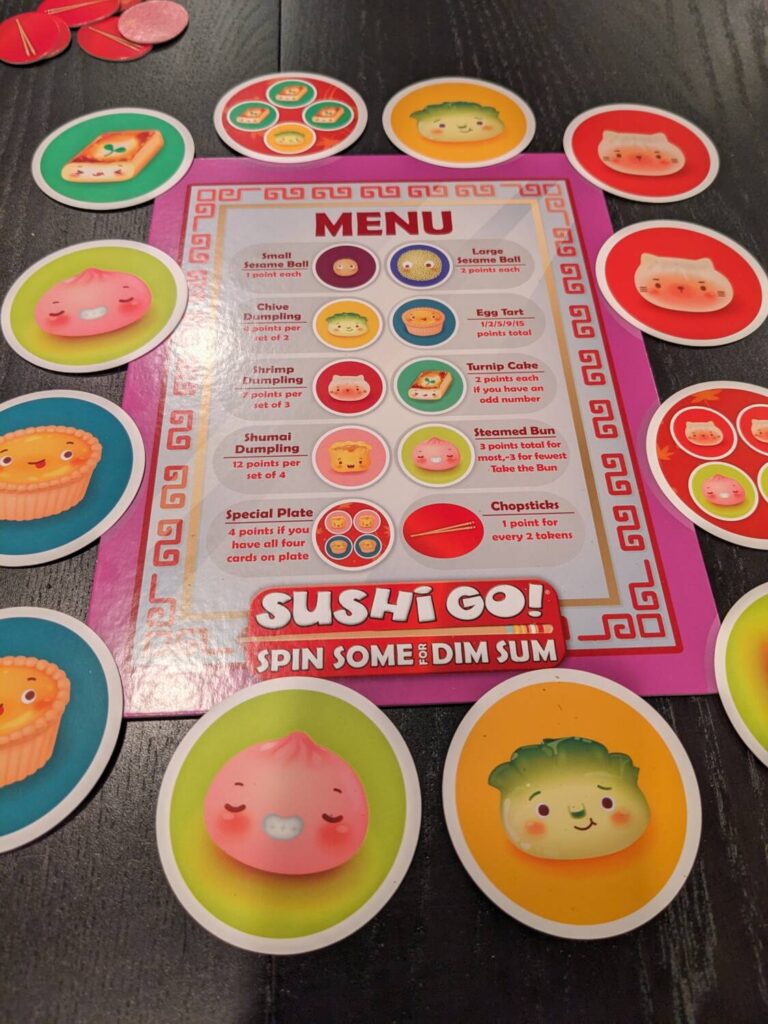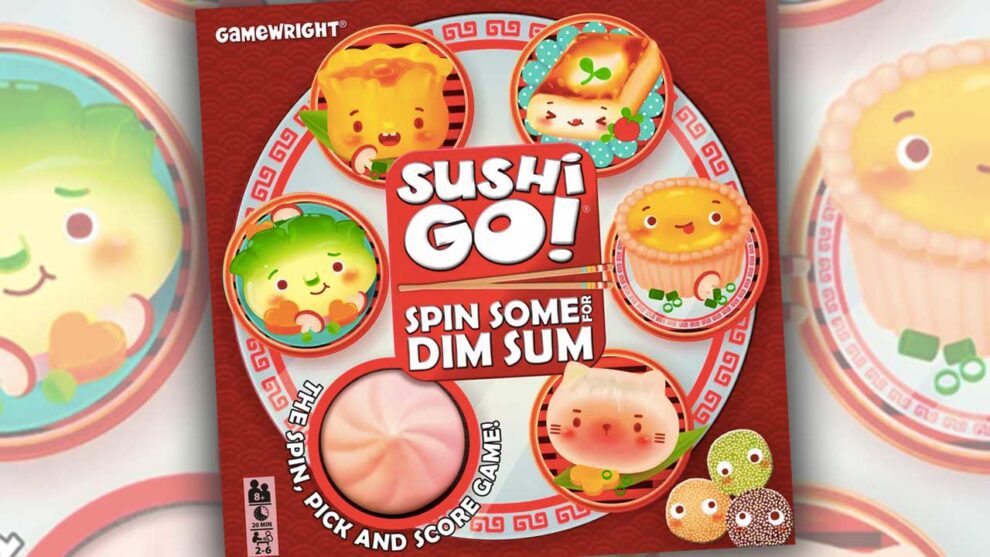Disclosure: Meeple Mountain received a free copy of this product in exchange for an honest, unbiased review. This review is not intended to be an endorsement.
I’ve played so much Sushi Go! over the years that I should be sick of it by now.
Nope! Between me, my gaming groups, and players around the world, Gamewright has made a mountain of cash on Sushi Go!, Sushi Go! Party, and Sushi Roll (my personal favorite, in part because there are dice). At this point, Gamewright is playing with house money, so it feels right that they are putting that house money to work.
The newest entry in the Sushi Go! family is Sushi Go!: Spin Some for Dim Sum, which uses a slightly different process to get to the game’s familiar result of low-scoring games full of cute art, set collection, and more chances to talk about Asian cuisine.
(A quick sidebar: I personally think of sushi as Japanese cuisine, even though there is plenty of evidence on The Internet that sushi actually originates in China, with a dish called “narezushi.” I’m not here to debate the origins of something that predates me by thousands of years, but even my children wondered about “the dim sum places in Chinatown” (near my old place in downtown Chicago) and the fact that this game is very blatantly called Sushi Go! without featuring any sushi. I know it’s a question for some of you, and I’m answering it by not answering it at all!!)
Feel free to dive into our previous Sushi Go! coverage—including our interview with Phil Walker-Harding, the designer of the original Sushi Go! production—if you want to get a sense of how the Sushi Go! games play. All of them feature versions of the same set collection scoring mechanic mixed with lower-scoring cards that are guaranteed to score. Spin Some for Dim Sum is no different.

You’ve still got food items that score straight up, one item that scores points for the person holding the most of that item at the end of the game (in this case, steamed buns), and a few items that only score if you collect enough of them to qualify for points. The main difference in Spin Some for Dim Sum is the delivery system.
A six-basket “Spin Table” is used to hold cards. Depending on a player’s seat, they can spend their turn taking the top face-up card from the basket in front of them, which gets added to their menu (player board). The menu has spots for 12 cards that will be accumulated during the game. If they don’t like the card in the basket in front of them, they can spin the wheel either clockwise or counterclockwise to take a different card, paying a chopsticks token for each space they spin the dial to take a different card, a bit like paying a coin for each card you want to skip to later take a card from the market in games like Pax Pamir 2E.
Spin Some for Dim Sum has 12 rounds and 12 different card types; one of those cards is the steamed bun, which grants three points to whoever has the most of that card by the end of play. In addition, each time a player takes a steamed bun, they get to take a real-life plushie steam bun toy that Gamewright included in the box. This token can be used on a player’s turn to take any card from the six face-up cards in the tray, without spending any chopsticks.
Turns continue like this until every player has 12 cards. Games of Spin Some for Dim Sum last 10-15 minutes.

So, Do I Need It?
Spin Some for Dim Sum is firmly in “it’s alright” territory. That’s because all of the other Sushi Go! games are really good, leaving Spin Some for Dim Sum as the “worst” of the Sushi Go! games. Even the basic Sushi Go! card game is better than Spin Some for Dim Sum.
The major upgrade with this new game is the elevated production elements, namely the tray and dim sum baskets holding all the cards. (And, of course, the plushie.)
As an introduction to the world of Sushi Go! (this new game is being sold exclusively at Target), Spin Some for Dim Sum does the job. It is a breeze to set up and teach, and it accommodates up to six players. The artwork—featuring those smiling sesame balls, shrimp dumplings and turnip cakes—still works. On the night we broke this game open, we punched the chopstick tokens, read the rules from the instruction sheet, and played three complete three-player games in about 45 minutes before the kids went to bed.
It is fast. For Sushi Go! veterans, Spin Some for Dim Sum doesn’t move the needle in a meaningful way from the superior Sushi Go! family predecessors. Sushi Go! Party does everything this game does, with almost unlimited replayability, thanks to all the different types of sushi cards in the box. Sushi Roll is just more interesting to me because I love rolling the dice and pass-the-platter mechanic, passing leftover dice to the next player.
And Sushi Go! (the base game) is still a classic; the longevity here is amazing. I’m surprised that I still go to game nights a couple times each year where someone breaks out Sushi Go! because it fits in a purse and can be taught to people who have never played a card game before.
That leaves Spin Some for Dim Sum in a tough place. I recommend it if you are looking for a way to learn the game for the first time and want to spend a little more on above-average production. But if you already own at least one other Sushi Go! product, stick with that because there’s not much new here to change up the gameplay.











